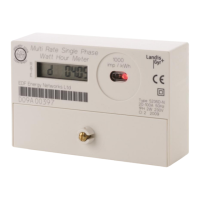
Do you have a question about the Landis & Gyr 5235 and is the answer not in the manual?
| Voltage | 230 V |
|---|---|
| Frequency | 50 Hz |
| Standard | IEC 62053-21 |
| Display | LCD |
| Operating Temperature | -25°C to +55°C |
| Storage Temperature | -40°C to +70°C |
| Communication | Optical port |
Details the functions for the variants of the 5235 Single Phase Credit Meters, active energy only.
Describes the meter as a static electricity meter measuring kWh, its approval, and features like optical port.
Explains that a character in the model number denotes the version (A, B, D).
Lists certifications from OFGEM, IEC62052-11, IEC62053-21 for active energy.
States the meter has a 20-year certification life granted by OFGEM.
Outlines the responsibilities of the meter owner and personnel working with meters.
Lists critical safety regulations to be observed at all times during operation.
Describes the meter's measurement capabilities, voltage, current, and metrology LED.
Explains the meter's anti-creep mode where the LED is lit, and registers do not increment.
Details how meter data is stored in Ferroelectric Random Access Memory (FRAM).
Explains the configurable reverse energy modes and export energy registration.
Details how single-rate and two-rate meters display kWh readings and rate information.
Explains the configurable Pulse Output feature for type B meters.
Describes the factory setting for rate switching via input terminals in D model meters.
Lists the materials used for the Credit Meter case, meeting BS5685 requirements.
Explains how the meter is mounted using fixing holes and terminal cover alignment.
Describes the terminal arrangement conforming to BS5685 and shows wiring diagrams for different meter types.
Provides a detailed technical overview including system voltage, current, accuracy, and standards.
Lists the physical dimensions of the meter for standard and extended terminal covers.
Lists checkpoints for scheduled periodic meter visits, focusing on cleanliness and display.
Describes periodic meter testing requirements according to national regulations.
Explains how to amend factory configured options using software and a laptop.
Guides checks for common operating faults like illegible LCD or power issues.
Provides a step-by-step procedure for safely disconnecting the meter.
Details the process for returning meters for repair, as internal parts are not serviceable.
Outlines the procedure for safe meter removal and disposal guidelines for component parts.
Provides a list of acronyms used in the document with their definitions.
Lists common measurement units and their corresponding quantities.